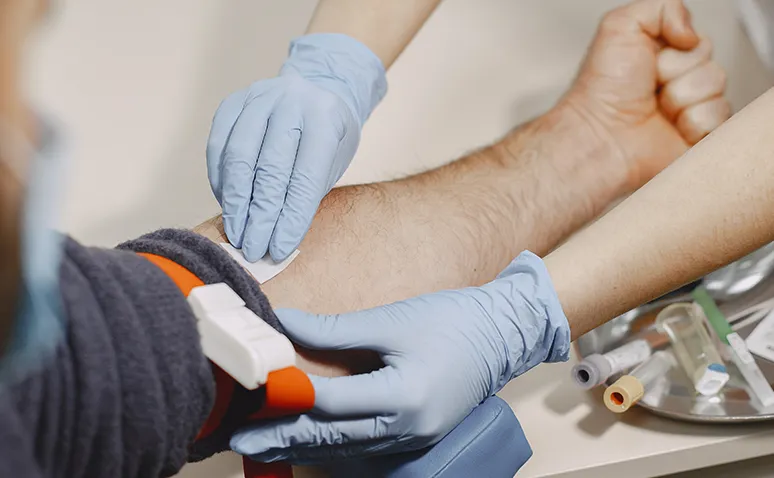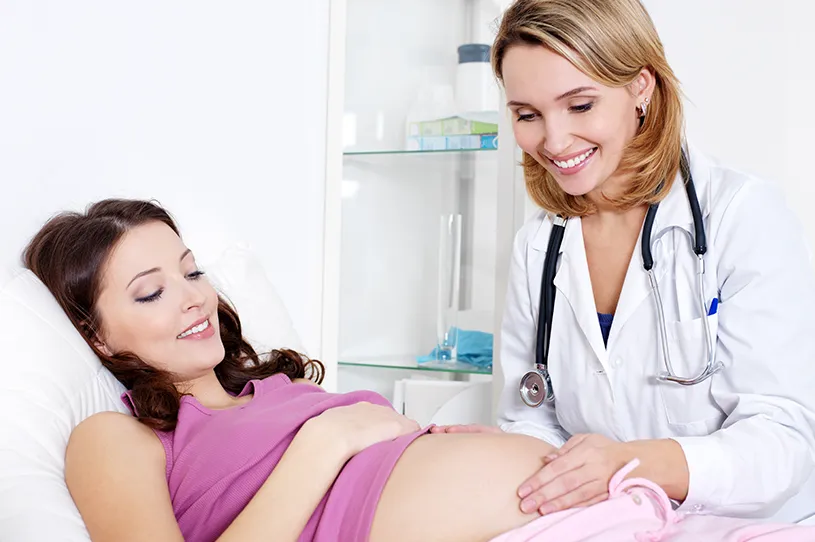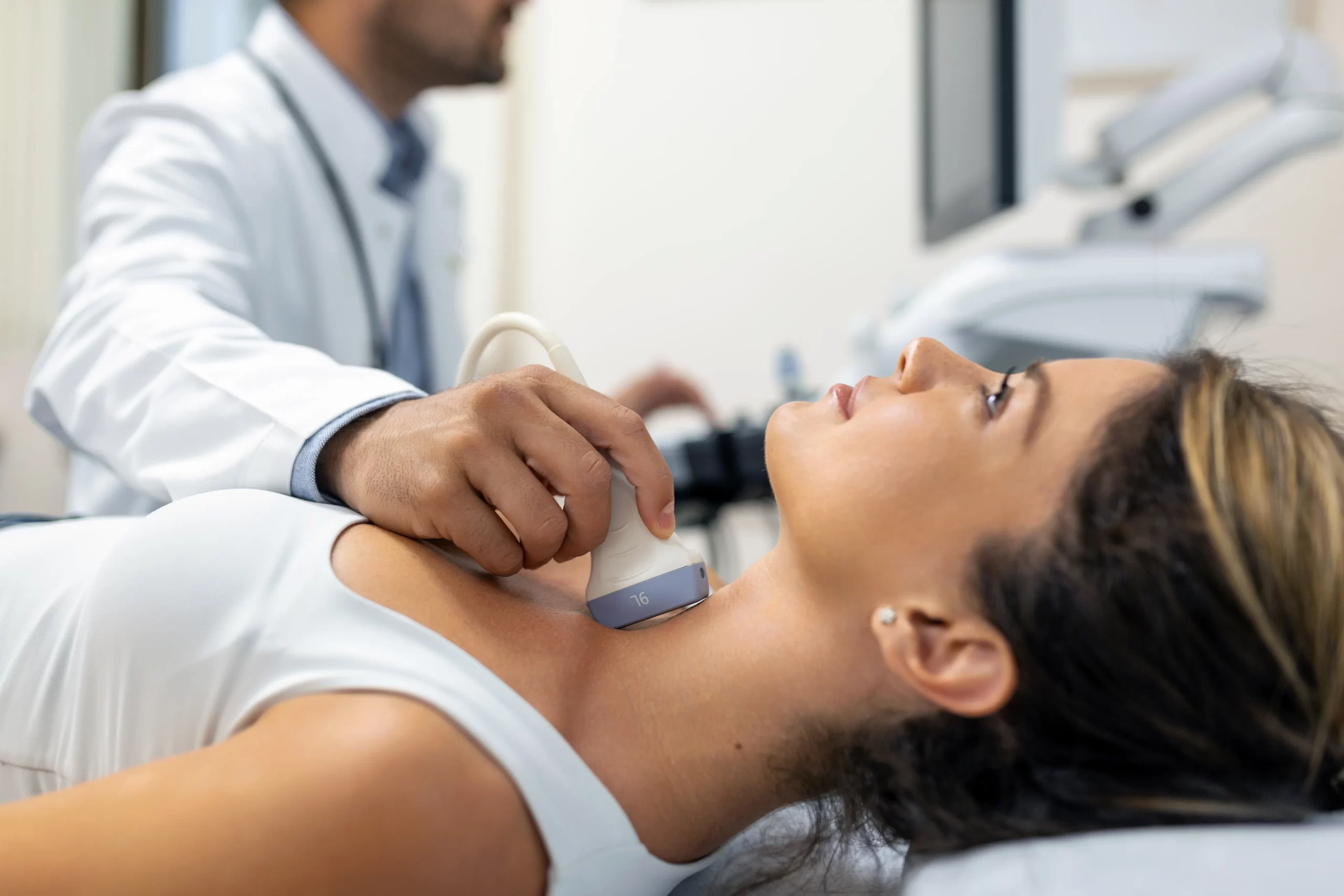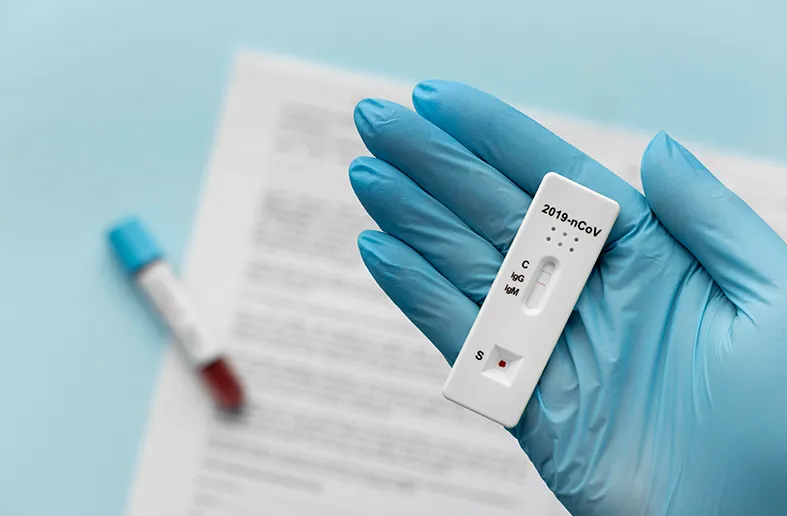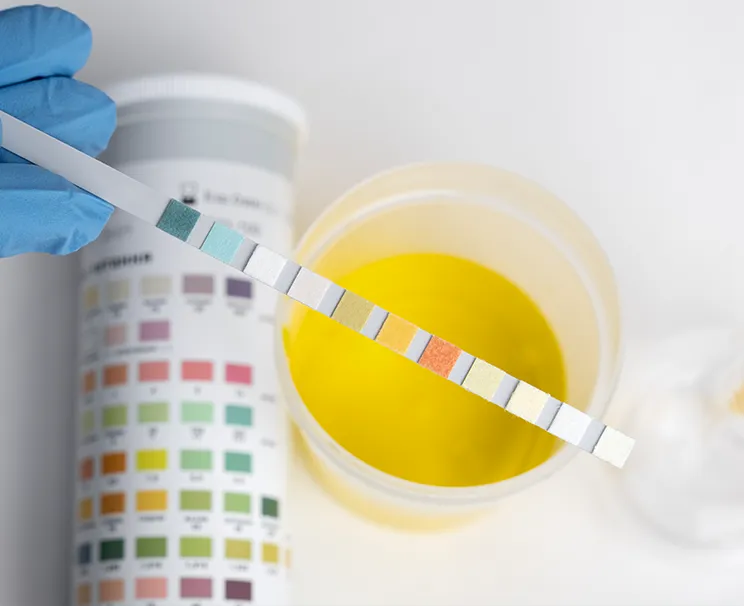
What is Down Syndrome?
Down Syndrome is characterized by the presence of an extra chromosome, chromosome numbered 21, in the fetus’s cells. In a society with no screening process, approximately one out of every 500 babies is born with Down Syndrome. It is not usually inherited. Therefore, even if there is no family history of Down Syndrome, the baby may be born with this condition.
Down Syndrome is one of the most common causes of severe learning disability. Also, it is often associated with other physical problems, such as heart failures or visual or hearing impairments. It is impossible to determine the degree of disability before the baby is born. About 9 out of 10 babies with Down Syndrome survive in their first year. And almost half of these babies reach the age of 60.
What Are Open Neural Tube Defects?
The two main types of neural tube defects (NTDs) are spina bifida and anencephaly.
Babies with spina bifida have gaps in their spinal bones. This gap can damage the nerves that control the lower part of the body. And this situation causes weakening of the legs, paralysis, and sometimes bowel and bladder problems. Babies with spina bifida are also more prone to water retention in the brain, called hydrocephalus. Hydrocephalus can be treated with surgery; however, it may cause hearing disorders.
In infants with anencephaly, most of the skull is missing. Therefore, the brain does not form as it should. These babies always die before or soon after birth.
In about one in five babies with spina bifida, the space in the spine is covered by a layer of skin or thick tissue. It is called closed spina bifida and cannot be detected by blood tests. This condition is usually less severe than open spina bifida.
What Does The Combined Test Include?
The combined test is most accurate at week 11 of pregnancy, but any time between weeks 10 and 13 is also acceptable. A blood sample is taken, and an ultrasound scan is done. Two Down Syndrome markers and one ultrasound marker are measured in the blood.
These two blood markers are:
- Plasma protein-A associated with pregnancy (PAPP-A)
- Free ß human chorionic gonadotropin (free ß–hCG)
And the ultrasound marker is:
- Nuchal translucency (NT)
While PAPP-A tends to decrease in Down Syndrome pregnancies, NT and free ß-hCG tend to increase.
The values of these three markers, together with age, are used to estimate the risk of Down Syndrome in pregnancy.
What Does the Integrated Test Include?
The integrated test is carried out in two stages. The integrated test is most accurate at week 11 of pregnancy, but any time between weeks 10 and 13 is also acceptable. Although the second stage can be done until the 22nd week, it is best done on the 15th or 16th.
Things done in the first stage:
- Ultrasound scan to pinpoint gestational age and measure nuchal translucency (NT) thickness (an area at the back of the baby’s neck)
- Blood sample collection for determination of pregnancy-related plasma protein-A (PAPP-A) concentration
- Providing a blood sample kit and suggesting a date to retake a blood sample for the second stage of the test
Things done in the second stage:
1. Taking a second blood sample to determine the concentrations of the following markers:
- Alpha-fetoprotein (AFP)
- Free ß human chorionic gonadotropin (free ß–hCG)
- Unconjugated oestriol (uE3)
- Inhibin-A
2. Integrating the measurements of the first and second stages into a single scan result. The risk of pregnancy with Down Syndrome is determined using the NT measurement and the levels of five markers in the blood with age.
While PAPP-A, AFP and uE3 levels tend to decrease in pregnancies with Down Syndrome, NT measurements, free ß-hCG and inhibin levels tend to increase.
The AFP level in the second blood sample is also used to identify increased risks of overt spina bifida or anencephaly.
Why Wait Until The Second Stage To Determine The Risk?
Because the result obtained with the information obtained in both stages is more reliable and more effective than the result obtained with the information obtained in only one step. In this way, problematic and non-problematic pregnancies can be distinguished more effectively, and the risk of not detecting a pregnancy with Down Syndrome is reduced. In addition, the need for invasive diagnostic tests such as amniocentesis or chorionic villus sampling (CVS) is reduced.
What Does The Quad Test Include?
Your blood sample is taken between the 14th and 22nd weeks of your pregnancy (the earliest time to screen for open neural tube defects is week 15). The stage of pregnancy is most realistically determined by ultrasound. The levels of four hormones in your blood are measured and compared to the average levels of your pregnancy. These substances are:
- Alpha-fetoprotein (AFP)
- Free Estradiol
- Free ß human chorionic gonadotropin (free ß–hCG)
- Inhibin-A
The concentration of these four substances, together with age, is used to estimate the risk of Down Syndrome in pregnancy.
While AFP and uE3 levels tend to decrease in pregnancies with Down Syndrome, free ß-hCG and inhibin levels tend to increase.
The AFP level is also used to identify increased risks of overt spina bifida or anencephaly.
What is ’Risk’?
Risk is the probability of an event occurring. For instance, 1 in 100 Down Syndrome risk means that one of every 100 women who have this test and get this result has Down Syndrome, while the remaining 99 babies will not have Down Syndrome. In other words, it means that 1% of the baby will have Down Syndrome and 99% will not have Down Syndrome.
How Soon Will The Test Results Be Available?
The result is usually ready and sent to the doctor within three working days of the sample reaching the laboratory.
The test result is either positive or negative.
What Does a Positive Result For Down Syndrome Mean?
A positive result means you are at high risk of having a baby with Down Syndrome. If you are at high risk, you will be offered diagnostic amniocentesis or possibly chorionic villus sampling (CVS).
If the risk of Down Syndrome is 1 in 200 and above, the result is positive. Approximately one out of every 20 women screened is in this group.
Most women with a positive result do not have Down Syndrome. For example, only one out of 20 women with a positive Down Syndrome test has a baby with Down Syndrome.
What Does a Positive Result For Open Neural Tube Defects Mean?
A positive result means you are in an increased risk group for having a baby with an open neural tube defect. If the result is positive, you will be advised to undergo an ultrasound scan and examination at 18 to 22 weeks of pregnancy and most likely to have an amniocentesis.
The result is positive if the AFP level is two or higher and is half the normal level of your gestational stage.
What Does a Negative Result Mean?
If the quad test result was less than 1 in 200 Down Syndrome risk, or if your AFP level was below two and half the normal level of your gestational stage, the result was negative. In this situation, diagnostic tests are generally not recommended.
While a negative result means that there is a low risk of having a baby with Down Syndrome or an open neural tube defect, it cannot completely rule out the possibility that one of these anomalies is present.
Can Screening Test Reveal All Problematic Pregnancies?
No. About 4 out of 5 Down Syndrome cases will occur (classified as positive). This means that one out of every 5 Down Syndrome pregnancies is undetected (classified as negative).
About 4 out of 5 open cases of spina bifida are found, while one in 5 cases are missed. Almost all cases of anencephaly are detected, on the other hand.
Why Do Women with Negative Results Occasionally Have a Baby with Down Syndrome or Open Neural Tube Defects?
It is not uncommon for a woman, especially for a woman who has a negative screening result, to have a baby with Down Syndrome or an open neural tube defect. However, this happens sometimes.
This is because the screening test cannot completely distinguish between problematic and non-problematic pregnancies. However small the risk, this test cannot completely rule out the possibility of a baby being born with Down Syndrome or an open neural tube defect.
Can Other Anomalies Be Detected?
Yes, some of the measurements used in the quad test can also detect pregnancies at high risk for Edwards Syndrome (trisomy 18).
Edwards Syndrome is a rare (one in 7000 births) and usually fatal anomaly. It occurs due to the presence of an extra chromosome 18 in the fetus’s cells. If the risk is 1 in 100 or greater, another ultrasound exam and amniocentesis will be recommended. The quad test can determine 6 out of 10 pregnancies with Edwards Syndrome.
Why Is Age Important?
Any woman, regardless of age, can have a baby with Down Syndrome. However, the probability of this happening increases with the woman’s age. Therefore, age is an important factor in determining the risk of Down Syndrome in pregnancy. This also means that there is a high probability that an older woman will be in the high-risk group (positive), and therefore further diagnostic testing is required. This is shown in the table below:
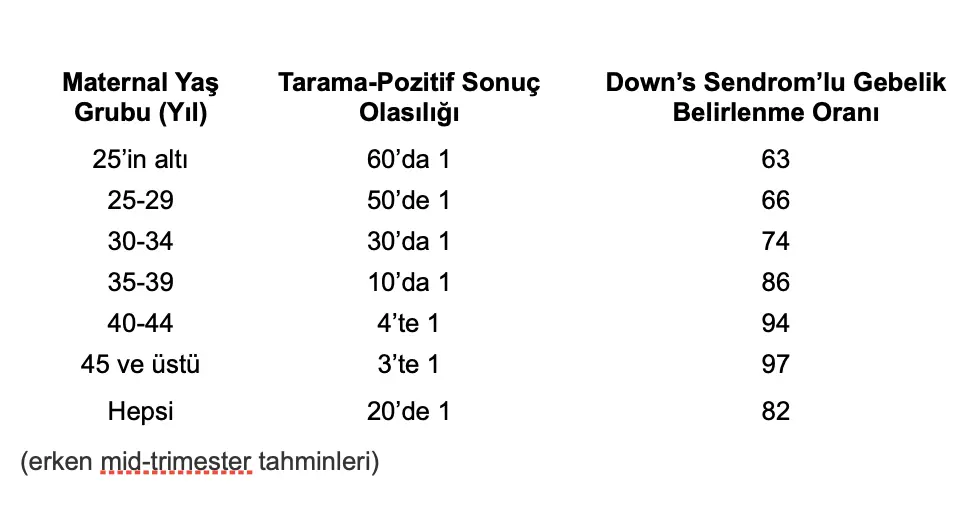
Tanı Testleri Nelerdir?
Eğer sonucunuz tarama-pozitifse, size bir tanı testi önerilecektir. Bu test genellikle amniyosentez ya da koryonik vilüs örneklemesi (CVS) olabilir. Tanı testi gebeliğinizde gerçekten bir anomali olup olmadığını tespit edecektir.
Amniyosentez: Amniyosentez basit ve yaygın olarak kullanılan bir prosedürdür. Gebeliğin yaklaşık 16. haftasında uygulanır ve abdominal duvardan bir iğne ile geçilerek bebeğin etrafından küçük bir amniyotik sıvı örneği alınması yoluyla yapılır. Bu sıvı bebeğin hücrelerini içerir.
Down’s Sendromu kantitatif floresan polimeraz zincir reaksiyonu (QF-PCR) denen bir teknik kullanılarak teşhis edilir. Bu teknik hızlı bir Down’s Sendromu teşhisi sağlar (amniyosentezden itibaren 48 saat içinde), ve aynı zamanda trizomi 18 ve 13 ile bazen de seks kromozomu anomalilerini teşhis eder. Bazı durumlarda tüm kromozomlar incelenir. Bunun sonuçlanması iki hafta kadar sürebilir.
Koryonik Vilüs Örneklemesi (CVS): Bu test amniyosenteze alternatif olarak önerilebilir. CVS gebeliğin erken döneminde (11 hafta civarı) önerilir ve uygulanması yalnızca birkaç dakika alır. CVS için abdominal duvardan bir iğne ile ya da serviksten sivri bir aletle geçilerek plasental dokudan (lokal anestezi ile) örnek alınır. İğne ultrason taraması rehberliğinde geçirilir. Amniyosentezde olduğu gibi Down Sendromu’nun, trizomi 18 ve 13’ün, ve bazen de seks kromozomu anomalilerinin hızlı teşhisi için QF-PCR kullanılır. Bazı durumlarda tüm kromozomlar incelenir. Bunun sonuçlanması iki hafta kadar sürebilir.
Küçük bir olasılıkla (yaklaşık 100’de 1), CVS nihai bir teşhis sağlayamayabilir. Böyle bir durumda amniyosentez yaptırmanız gerekmektedir.
Bu tanı testleri bebeğimde hiçbir doğum bozukluğu olmadığını garanti edebilir mi?
Hiçbir test bebeğinizde hiçbir doğum bozukluğu olmadığını garanti edemez; ama eğer amniyosentezin ya da CVS’in sonucu negatifse, bebeğinizde Down’s Sendromu, trizomi 18, 13, ve seks kromozomu anomalileri olmadığı neredeyse kesin olarak söylenebilir.
Amniyosentez ya da CVS Testleri Güvenli midir?
Amniyosentez ve CVS yıllardır yapılmakta olan prosedürlerdir. Güvenlikleri dikkatlice incelenmiştir ve amniyosentez ya da CVS olan her 100 kadından yalnızca 1’inde prosedür nedeniyle düşük gerçekleşebileceği belirlenmiştir.
Detaylı Ultrason Taraması
- Anansefali ve Spina Bifida: Detaylı tarama anansefali ve açık spina bifida’nın teşhisi için kullanılır.
- Down’s Sendromu: Ultrason taraması ile Down’s Sendromu’nu teşhis etmek mümkün değildir. Fakat Down’s Sendromu ile ilişkilendirilebilecek bir takım fiziksel özellikler 18 ve 22. haftalar arasındaki ultrason taramalarında görülebilir. Eğer bu özelliklerden biri görülürse bu bir tanı testi yapılması gerekliliğini gösterebilir ama bu özelliklerin gözlenmemesi Down’s Sendromu riskini tamamen göz ardı edemez.
Eğer Problemli Bir Gebeliğim Yoksa, Sonucum Neden Tarama-Pozitif Çıkar?
Tarama testi sonuçları yaşınız ve kan marker seviyelerinizle bağıntılıdır. Dolayısıyla, eğer yaşınız ileriyse, AFP veya uE3 düzeyleriniz düşükse, ve eğer inhibin veya serbest ß-hCG seviyeleriniz yüksekse, tarama-pozitif sonucu alma olasılığınız daha fazladır. Fakat, bu dört maddenin seviyelerinin doğal olarak her kadında değiştiği göz önüne alındığında, genellikle bir kadının düşük ya da yüksek seviyelere sahip olmasının belirgin bir sebebi yoktur. Bu nedenle, tarama-pozitif sonucu alan çoğu kadında problemli gebelik gözlenmez. Tarama-pozitif sonucu yalnızca kişinin yüksek risk grubu içerisinde olduğunu gösterir ve bir tanı testine ihtiyacımız olduğunu bilmemizi sağlar.
Bebeğimde Down’s Sendromu ya da Nöral Tüp Defekti Varsa Ne Olur?
Unutulmamalıdır ki, dörtlü test sonuçlarınız tarama-pozitif olsa bile, bebeğinizde Down’s Sendromu ya da açık nöral tüp defekti olmama olasılığı daha yüksektir. Eğer bebeğinizde bu anomalilerden biri varsa, bunun sonuçlarını öğrenmek ve opsiyonlarınızı değerlendirmek üzere bir danışmana yönlendirileceksiniz. Eğer gebeliğinizi sürdürmeye karar verirseniz, bebeğinizle doğru şekilde ilgilenmek için özel yardım ve destek almak üzere birilerine danışabilirsiniz. Eğer gebeliğinizi sonlandırmaya karar verirseniz, doktorunuz gerekli işlemleri sizin için yapabilir.

